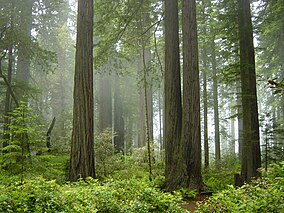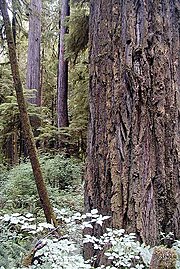Redwoods Rising
| Redwoods Rising joint venture in Redwood National and State Parks | |
|---|---|
 A forest of coast redwoods in fog | |
| Location | Redwood National and State Parks in Humboldt County & Del Norte County, California, US |
| Coordinates | 41°18′N 124°00′W / 41.3°N 124°W |
| Established | April 2018 |
| Website | www |

Redwoods Rising is a joint venture of the Save the Redwoods League, California State Parks, and the National Park Service that works together to restore logged Coastal Redwood forests, and help remain old growth forests in Redwood National and State Parks. Redwoods Rising also works with local Native American tribes.[1][2] Redwoods Rising was founded in April 2018 at an event in Prairie Creek Redwoods State Park. Redwood National and State Parks as 120,000 acres (49,000 ha) of public lands, 80,000 acres (32,000 ha) of this land were commercially logged in the past.[3] About 96 percent of the world's old-growth coast redwood forest has been logged. The works is been done in the California Coast Ranges in North Coast of California's Redwood forests.[4] Almost half (about 45 percent) of what remains is in the Redwood National and State Parks. The Redwoods Rising projects are also helping to restore the health of streams, also the fish and amphibians that live there. Coastal Redwoods are the tallest tree species on Earth. Coastal Redwood live only in the humid temperate rainforest of North Coast of California and Southern Oregon.[4][5] Redwood National and State Parks contain land and villages belonging to the Native American groups Yurok and Tolowa. Yurok Indian Reservation is partly in the park.[6]
Parks
[edit]Parks in the Redwood National and State Parks, that Redwoods Rising works in:
- Del Norte Coast Redwoods State Park
- Jedediah Smith Redwoods State Park
- Prairie Creek Redwoods State Park
Redwoods Rising projects have been done in the Mill Creek watershed and Prairie Creek watershed.[7]
Goals
[edit]Stated goals of Redwoods Rising:[3]
- Create a shared restoration strategy
- Enhance capacity for larger and more frequent restoration projects
- Develop dedicated and increased funding to support ecosystem restoration
- Build and expand public support for restoring, protecting, and stewarding redwood ecosystems
See also
[edit]- California Department of Parks and Recreation
- National parks in California
- List of national parks of the United States
References
[edit]- ^ "Redwoods Rising | Save the Redwoods League".
- ^ "Directions". National Park Service. January 7, 2023. Archived from the original on June 4, 2023. Retrieved February 3, 2024.
- ^ a b "Redwoods Rising FAQs". Redwood National and State Parks | U.S. National Park Service. April 23, 2024.
- ^ a b "Frequently Asked Questions". National Park Service. August 17, 2008. Archived from the original on August 15, 2023. Retrieved August 14, 2023.
- ^ "When you picture a redwood forest" (PDF). Redwoods Rising. Archived (PDF) from the original on December 28, 2023. Retrieved March 7, 2024 – via Save the Redwoods League.
- ^ "Redwood National and State Parks: General Management Plan, General Plan (Summary)" (PDF). National Park Service and State of California. pp. 3, 6. Archived (PDF) from the original on October 17, 2023. Retrieved October 16, 2023.
- ^ "Redwoods Rising Overview | Save the Redwoods League".
External links
[edit]Jedediah Smith Redwoods State Park.
- Official website of Redwood National Park
- Official website of Jedediah Smith Redwoods State Park
- Official website of Humboldt Redwoods State Park
- Official website of Prairie Creek Redwoods State Park
- Inventory of the Redwood National Park Collection, 1926–1980, at Forest History Society



